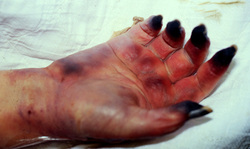Frostbite: First aid

Frostbite occurs when tissues freeze. This condition happens when you are exposed to temperatures below the freezing point of skin. When exposed to very cold temperatures, skin and underlying tissues may freeze, resulting in frostbite. The areas most likely to be affected by frostbite are your hands, feet, nose and ears.If your skin looks white or grayish-yellow, is very cold and has a hard or waxy feel, you may have frostbite. Your skin may also itch, burn or feel numb. Severe frostbite can cause blistering and hardening. As the area thaws, the flesh becomes red and painful.
causes:
Factors that contribute to frostbite include extreme cold, inadequate clothing, wet clothes, wind chill, and poor blood circulation. Poor circulation can be caused by tight clothing or boots, cramped positions, fatigue, certain medications, smoking, alcohol use, or diseases that affect the blood vessels, such as diabetes. Exposure to liquid nitrogen and other cryogenic liquids can cause frostbite.
causes:
Factors that contribute to frostbite include extreme cold, inadequate clothing, wet clothes, wind chill, and poor blood circulation. Poor circulation can be caused by tight clothing or boots, cramped positions, fatigue, certain medications, smoking, alcohol use, or diseases that affect the blood vessels, such as diabetes. Exposure to liquid nitrogen and other cryogenic liquids can cause frostbite.
- Protect your skin from further exposure. If you're outside, warm frostbitten hands by tucking them into your armpits. Protect your face, nose or ears by covering the area with dry, gloved hands. Don't rub the affected area and never rub snow on frostbitten skin..
- Get out of the cold. Once you're indoors, remove wet clothes.
- Gradually warm frostbitten areas. Put frostbitten hands or feet in warm water — 104 to 107.6 F (40 to 42 C). Wrap or cover other areas in a warm blanket. Don't use direct heat, such as a stove, heat lamp, fireplace or heating pad, because these can cause burns.
- Warming can be achieved in one of two ways:
Passive rewarming involves using body heat or ambient room temperature to aid the person's body in rewarming itself. This includes wrapping in blankets or moving to a warmer environment.
Active rewarming is the direct addition of heat to a person, usually in addition to the treatments included in passive rewarming. Active rewarming requires more equipment and therefore may be difficult to perform in the prehospital environment.
